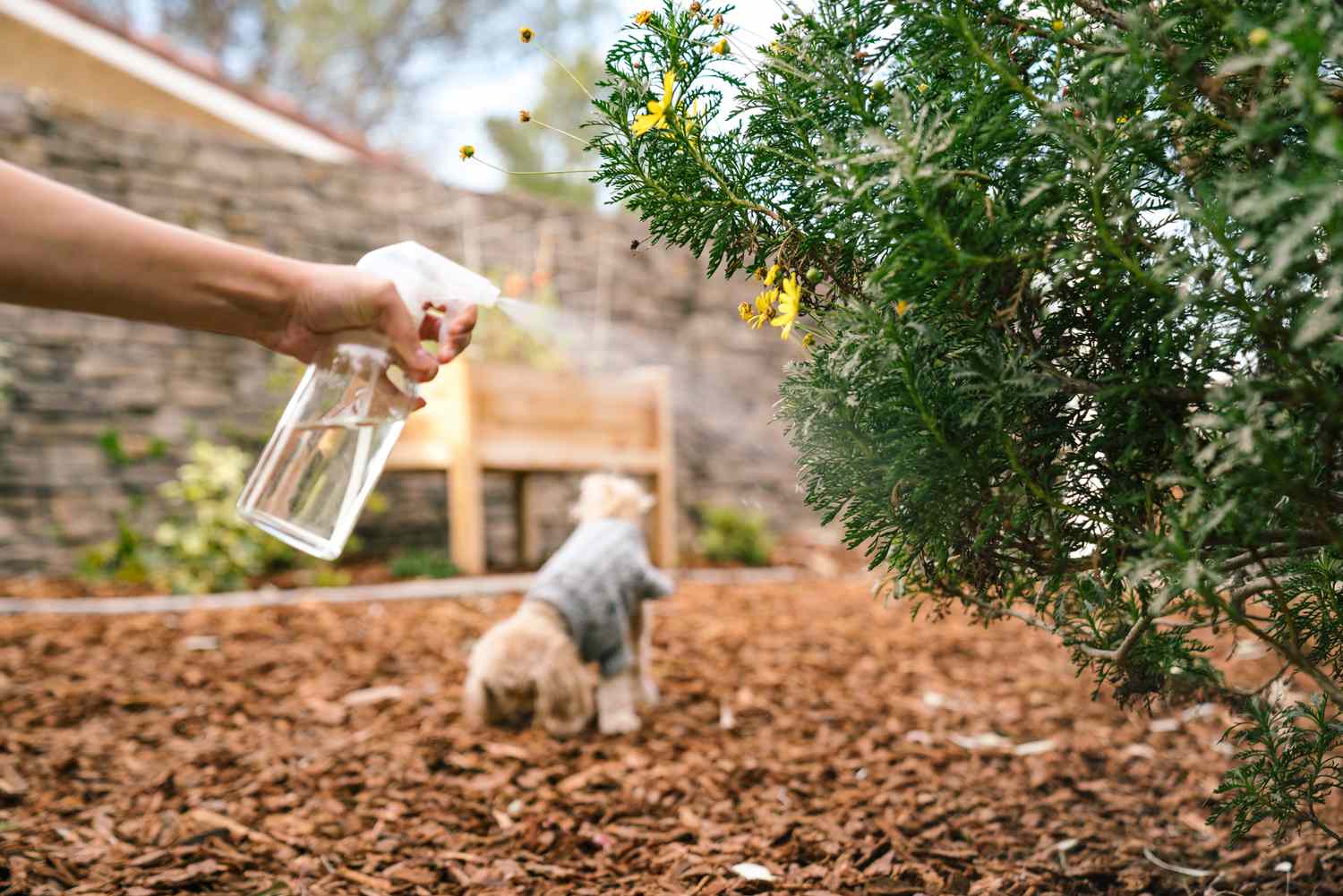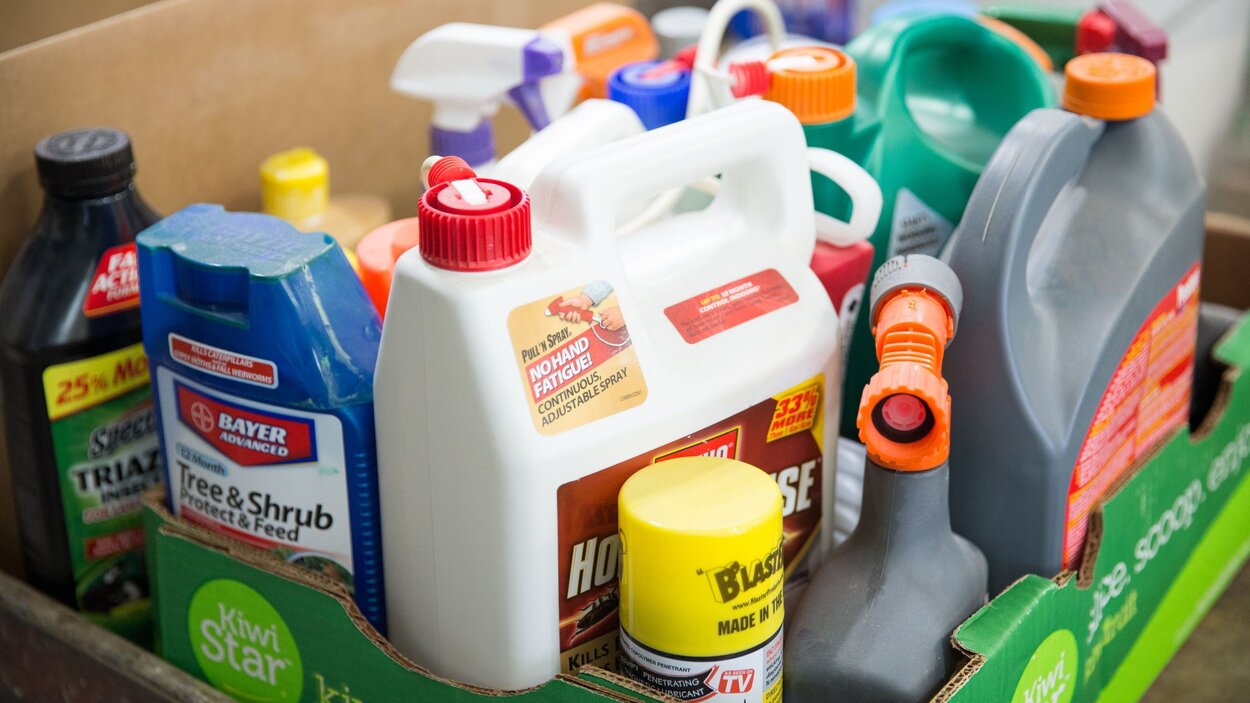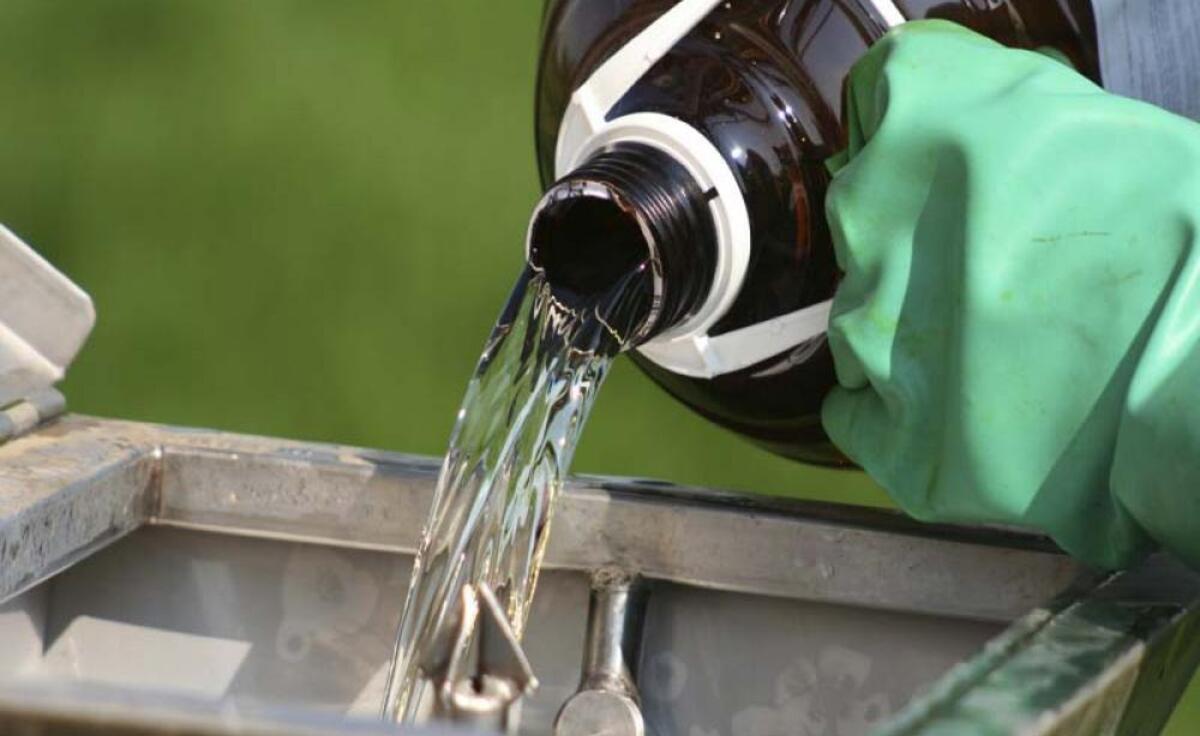Home>Gardening News and Trends>Latest News>How Long Are Pesticides Toxic To Dogs


Latest News
How Long Are Pesticides Toxic To Dogs
Published: November 23, 2023
Discover the latest news on how long pesticides can remain toxic to dogs, and learn how to protect your furry friend from harmful exposure.
(Many of the links in this article redirect to a specific reviewed product. Your purchase of these products through affiliate links helps to generate commission for Chicagolandgardening.com, at no extra cost. Learn more)
Table of Contents
- Introduction
- Understanding Pesticides and Their Toxicity
- Common Pesticides Used and Their Potential Harm to Dogs
- Factors Influencing the Duration of Pesticide Toxicity in Dogs
- Symptoms of Pesticide Poisoning in Dogs
- Treatment and Management of Pesticide Poisoning in Dogs
- Prevention Measures to Protect Dogs from Pesticide Exposure
- Conclusion
Introduction
Pesticides are commonly used substances that help control pests and maintain the health and productivity of crops, gardens, and homes. However, these chemicals can pose a significant risk to the well-being of our furry companions – dogs. Understanding the potential toxicity of pesticides and their duration of harm is essential for dog owners to provide a safe environment for their pets.
Exposure to pesticides can occur through direct contact, ingestion of contaminated food or water, or inhalation of pesticide fumes. Dogs are particularly vulnerable to pesticide toxicity due to their curious nature, tendency to explore outdoor environments, and potential exposure while playing or walking in treated areas.
The toxic effects of pesticides on dogs can vary depending on the specific chemical and its concentration. Some pesticides can cause immediate symptoms, while others may have delayed effects that can be more challenging to identify. Therefore, it is crucial to be aware of common pesticides and their potential harm to dogs.
This article aims to provide a comprehensive understanding of the duration of pesticide toxicity in dogs, including the factors that influence it, the symptoms of pesticide poisoning, and the necessary treatment and management strategies. Furthermore, proactive prevention measures that can help protect dogs from pesticide exposure will be discussed.
By increasing our knowledge about the potential risks associated with pesticides and implementing preventive measures, we can safeguard the well-being of our beloved dogs and ensure their health and happiness.
Understanding Pesticides and Their Toxicity
Pesticides are chemical substances that are designed to eliminate or control pests such as insects, weeds, fungi, and rodents. They are widely used in agriculture, landscaping, and pest control practices. While these pesticides are effective in their intended purpose, they can also pose a risk to both humans and animals, including dogs.
Pesticides can be categorized into different types based on their mode of action and chemical composition. These include insecticides, herbicides, fungicides, rodenticides, and many others. Each type of pesticide is formulated to target specific pests, but they all share the potential to cause toxicity to animals when exposure occurs.
The toxicity of pesticides is determined by several factors, including the specific chemical used, the dose or concentration of the pesticide, and the route of exposure. Dogs can come into contact with pesticides through ingestion, inhalation, or skin absorption. It’s important to note that even small amounts of certain pesticides can be harmful to dogs, as they are more sensitive to these toxic substances than humans.
Pesticides can have various adverse effects on dogs, depending on the specific chemical involved. These effects can range from mild symptoms such as skin irritation and gastrointestinal upset to more severe consequences like neurological damage, organ failure, and even death. Additionally, certain pesticides have the potential to accumulate in the body over time, leading to long-term health issues.
It’s crucial for dog owners to be aware of the potential toxicity of pesticides and take necessary precautions to minimize their pets’ exposure. This includes being cautious when using pesticides around the home, ensuring that treated areas are properly ventilated, and keeping dogs away from recently sprayed surfaces.
Furthermore, understanding the signs and symptoms of pesticide poisoning in dogs is essential for early detection and prompt intervention. Common symptoms include vomiting, diarrhea, excessive salivation, lethargy, tremors, difficulty breathing, and seizures. If you suspect that your dog has been exposed to pesticides and is displaying any of these symptoms, it is important to seek veterinary care immediately.
In the following sections, we will explore common pesticides used and their potential harm to dogs, as well as the factors that influence the duration of pesticide toxicity in dogs. This knowledge will help dog owners better understand the risks associated with pesticide exposure and take appropriate measures to protect their furry friends.
Common Pesticides Used and Their Potential Harm to Dogs
There are numerous pesticides commonly used in various settings, including homes, gardens, and agricultural fields. While these chemicals are effective in controlling pests, it’s important to be aware of their potential harm to dogs if they come into contact with them.
1. Insecticides: Insecticides are designed to target and eliminate insects. They can be found in sprays, baits, and powders. Certain insecticides, such as organophosphates and carbamates, can be highly toxic to dogs. These chemicals can cause symptoms like drooling, vomiting, diarrhea, tremors, and even respiratory distress. Dogs can be exposed to insecticides through direct contact with treated surfaces or by ingesting contaminated materials.
2. Herbicides: Herbicides are used to control weeds and unwanted vegetation. Glyphosate-based herbicides, such as Roundup, are widely used but can pose a risk to dogs if ingested. Symptoms of glyphosate toxicity in dogs may include gastrointestinal upset, lethargy, and in severe cases, damage to the kidneys or liver.
3. Rodenticides: Rodenticides are used to control rodent populations. Commonly used rodenticides contain anticoagulant chemicals, which interfere with blood clotting. Unfortunately, dogs can inadvertently consume these toxins when they come into contact with poisoned rodents or eat the rodenticide directly. Anticoagulant rodenticides can cause internal bleeding, leading to symptoms such as weakness, pale gums, coughing, and blood in urine or stool.
4. Fungicides: Fungicides are used to control fungal diseases in plants. Some fungicides, such as organophosphates and copper-based fungicides, can be toxic to dogs. Symptoms of fungicide poisoning may include vomiting, diarrhea, lethargy, and respiratory distress.
It’s important to note that these are just a few examples of common pesticides and their potential harm to dogs. There are numerous other pesticide products available in the market, each with its own set of potential toxicities. It is crucial for dog owners to read and follow the instructions on pesticide labels carefully and take precautionary measures to prevent their pets from coming into contact with these chemicals.
If you suspect that your dog has been exposed to pesticides or displaying any symptoms of pesticide poisoning, seek immediate veterinary attention. Remember, prevention is key when it comes to protecting your furry friends from pesticide-related harm.
Factors Influencing the Duration of Pesticide Toxicity in Dogs
The duration of pesticide toxicity in dogs can vary depending on several factors. Understanding these factors is crucial for evaluating the potential long-lasting effects of pesticide exposure in dogs.
1. Type of Pesticide: Different pesticides have distinct chemical compositions and modes of action, which can influence their persistence in the body and duration of toxicity. Some pesticides may be rapidly metabolized and eliminated from the system, resulting in a shorter duration of toxicity. However, certain pesticides can accumulate in tissues or organs, leading to prolonged toxicity even after initial exposure has ceased.
2. Dose and Concentration: The amount of pesticide ingested or absorbed by a dog plays a significant role in determining the duration of toxicity. Higher doses or concentrations of pesticides are more likely to result in severe and longer-lasting toxicity. It’s important to note that even low levels of certain pesticides can have adverse effects on dogs, especially if exposure is continuous or repeated over time.
3. Route of Exposure: The route through which a dog is exposed to pesticides can also impact the duration of toxicity. Ingestion, inhalation, and dermal contact are the main routes of exposure. Ingestion of pesticides may result in longer-lasting systemic effects, as the chemicals are absorbed into the bloodstream directly. Inhalation and dermal exposure may cause initial acute symptoms, but the duration of toxicity may be shorter if the pesticides are not absorbed as extensively as when ingested.
4. Individual Sensitivity: Dogs, like humans, can have varying levels of sensitivity to pesticides. Factors such as age, breed, overall health, and genetic predisposition can influence an individual dog’s ability to metabolize and eliminate toxic substances. Some dogs may be more susceptible to the effects of certain pesticides, leading to longer-lasting toxicity even with low levels of exposure.
5. Timely Intervention and Treatment: Prompt recognition and appropriate veterinary intervention are crucial in minimizing the duration of pesticide toxicity in dogs. Timely treatment can help eliminate or detoxify the pesticide from the body more efficiently, reducing the risk of long-term effects. Therefore, it’s important to seek veterinary care as soon as possible if exposure to pesticides is suspected, even if the dog appears to be symptom-free.
It’s essential to remember that the duration of pesticide toxicity can vary from dog to dog and depend on the specific circumstances of exposure. While some toxic effects may be short-lived, others can persist for an extended period, potentially leading to chronic health issues. Taking proactive measures to prevent pesticide exposure and seeking veterinary care if exposure occurs are crucial steps in mitigating the duration of pesticide toxicity in dogs.
Symptoms of Pesticide Poisoning in Dogs
Pesticide poisoning can have a range of symptoms in dogs, and it’s important for pet owners to be able to recognize these signs to seek appropriate veterinary care promptly. The symptoms of pesticide poisoning can vary depending on the specific pesticide and the route and duration of exposure. Here are some commonly observed symptoms of pesticide poisoning in dogs:
1. Gastrointestinal Disturbances: Vomiting and diarrhea are common symptoms of pesticide poisoning in dogs. These symptoms may occur shortly after exposure to the pesticide or may develop over time. In some cases, the vomit or feces may contain traces of the pesticide or blood.
2. Excessive Salivation: Dogs exposed to certain pesticides may experience increased salivation or drooling. This symptom is often seen along with other neurological or gastrointestinal signs of pesticide toxicity.
3. Respiratory Distress: Inhalation of pesticide fumes or the direct exposure of the respiratory system to pesticides can lead to respiratory symptoms in dogs. Coughing, wheezing, difficulty breathing, or rapid breathing may be observed in such cases.
4. Neurological Symptoms: Pesticides can affect the central nervous system of dogs, leading to various neurological symptoms. These may include tremors, seizures, muscle twitching, uncoordinated movements, weakness, or paralysis. Changes in behavior, confusion, or disorientation may also be observed.
5. Skin Irritation: Some pesticides can cause skin irritation and dermatitis in dogs, especially if there is direct contact. This may manifest as redness, itching, rashes, or sores on the skin.
6. Changes in Urination: Certain pesticides, particularly those affecting the kidneys, can alter a dog’s urination pattern. Increased or decreased urine output, blood in the urine, frequent urination, or difficulty in urinating may be indicative of pesticide poisoning.
It’s important to note that symptoms of pesticide poisoning may not always manifest immediately after exposure. Delayed symptoms can occur in cases of chronic exposure or certain types of pesticides. Additionally, the severity of symptoms can vary depending on the dose and duration of exposure.
If your dog exhibits any of these symptoms or if you suspect pesticide poisoning, it is crucial to seek veterinary attention immediately. Do not attempt any home remedies or induce vomiting without first consulting a veterinarian, as certain actions may worsen the situation or be contraindicated.
Remember, the early recognition and treatment of pesticide poisoning can significantly improve the chances of a positive outcome and reduce the risk of long-lasting effects on your dog’s health.
Treatment and Management of Pesticide Poisoning in Dogs
When a dog is suspected of pesticide poisoning, immediate veterinary intervention is crucial to prevent further harm and provide appropriate treatment. The specific treatment and management approach will depend on the type of pesticide, the severity of symptoms, and the route of exposure. Here are key considerations in the treatment and management of pesticide poisoning in dogs:
1. Stabilization: The first step in managing pesticide poisoning is to stabilize the dog’s condition. This may involve supportive care to address symptoms such as vomiting, diarrhea, or respiratory distress. Intravenous fluids may be administered to maintain hydration, while medications may be given to control seizures, tremors, or other neurological symptoms.
2. Decontamination: If the pesticide was recently ingested, your veterinarian may induce vomiting or perform gastric lavage to remove as much of the toxin as possible from the dog’s stomach. Activated charcoal may also be administered to absorb any remaining pesticide in the digestive tract.
3. Antidotes and Specific Treatments: In certain cases, specific antidotes or treatments may be available for pesticide poisoning. For example, if the dog has ingested an anticoagulant rodenticide, vitamin K supplementation may be necessary to counteract the adverse effects on blood clotting. Your veterinarian will determine the most appropriate treatment based on the specific pesticide involved.
4. Symptomatic Care: Dogs with pesticide poisoning may require additional symptomatic care depending on their symptoms and overall condition. This may include administering anti-nausea medications, providing oxygen therapy for respiratory distress, or administering medications to support organ function.
5. Monitoring and Follow-up: After initial treatment, it is important to closely monitor the dog’s progress during recovery. Regular follow-up visits to the veterinarian may be necessary to assess the dog’s overall health, monitor organ function, and ensure that there are no long-term complications related to pesticide exposure.
6. Preventive Measures: Once a dog has experienced pesticide poisoning, it’s crucial to take preventive measures to avoid future incidents. This includes storing pesticides securely, keeping dogs away from treated areas until they are deemed safe, and using pet-safe alternatives whenever possible.
Remember, every case of pesticide poisoning is unique, and treatment may vary depending on the specific circumstances. It is always best to consult with a veterinarian who can provide personalized guidance and ensure the best possible care for your dog.
By acting quickly, seeking veterinary care, and following the recommended treatment and management strategies, the chances of a successful recovery increase. Proper treatment and ongoing management are essential for minimizing the potential long-term effects of pesticide poisoning on your dog’s health.
Prevention Measures to Protect Dogs from Pesticide Exposure
Preventing pesticide exposure is crucial to safeguarding the health and well-being of our furry companions. By implementing preventive measures, dog owners can reduce the risk of pesticide poisoning and create a safer environment for their pets. Here are some effective prevention measures to protect dogs from pesticide exposure:
1. Read and Follow Instructions: It is important to carefully read and follow the instructions on pesticide labels. This includes understanding the recommended application methods, dosage, and restrictions. Always use pesticides according to the manufacturer’s guidelines to minimize the risk of accidental exposure.
2. Choose Pet-Safe Alternatives: Whenever possible, opt for pet-safe alternatives to chemical pesticides. There are natural and organic products available that can effectively control pests without posing a threat to your dog’s health. Consult with a professional landscaper or pest control expert who specializes in pet-friendly methods and products.
3. Limit Access to Treated Areas: Keep your dog away from areas that have been treated with pesticides until they are deemed safe. Follow the recommended waiting period mentioned on the pesticide label or advised by the professional applicator. Restrict access by using barriers, fences, or keeping dogs indoors during or immediately after pesticide application.
4. Store Pesticides Securely: Store pesticides and other toxic substances securely, preferably in locked cabinets or high shelves that are out of your dog’s reach. Make sure containers are tightly sealed to prevent accidental spills or leaks. Keep in mind that some dogs can be skilled at opening cabinets, so take extra precautions to ensure their safety.
5. Avoid Pesticide Drift: Be cautious when using pesticides outdoors, especially in windy conditions. Pesticide drift can carry toxic particles over a wider area, increasing the risk of exposure for your dog. Avoid using pesticides near areas where your dog spends time, such as play areas or their outdoor kennel.
6. Provide Safe Water Sources: Ensure that your dog has access to clean, uncontaminated water sources. Avoid using pesticides near water bowls or sources, as the pesticide can contaminate the water and be ingested by your dog.
7. Educate Yourself: Stay informed about common pesticides, their potential toxicities, and any specific risks they pose to dogs. This knowledge can help you make informed decisions, identify warning signs of pesticide poisoning, and take appropriate action if an incident occurs. Look for guidance from reputable sources such as veterinarians, pet-specific organizations, or pest control professionals.
Remember, prevention is always better than treatment when it comes to pesticide exposure in dogs. By implementing these prevention measures and being vigilant about the risks associated with pesticides, you can significantly reduce the likelihood of your dog experiencing pesticide poisoning and ensure their well-being and safety.
Conclusion
Pesticide exposure can pose significant risks to the health and well-being of our furry companions, but with proper knowledge and preventive measures, we can protect our dogs from pesticide poisoning. Understanding the potential toxicity of pesticides, recognizing the symptoms of pesticide poisoning, and seeking prompt veterinary care are crucial steps in ensuring the best possible outcome for our pets.
By being aware of the common types of pesticides used and their potential harm to dogs, we can take proactive steps to minimize exposure. Choosing pet-safe alternatives, following pesticide application instructions, and limiting access to treated areas can greatly reduce the risk of accidental ingestion or contact with pesticides.
In the event of pesticide poisoning, immediate veterinary care is essential. Stabilizing the dog’s condition, decontamination if necessary, and appropriate treatment tailored to the specific pesticide involved are crucial for a successful recovery. Continuing to monitor the dog’s progress during recovery and implementing preventive measures to avoid future incidents are equally important.
Remember, prevention is key when it comes to protecting our dogs from pesticide exposure. By staying informed, using pet-safe alternatives, and taking necessary precautions, we can create a safe and healthy environment for our furry friends.
Ultimately, the well-being of our dogs depends on our vigilance and dedication to their safety. By prioritizing their protection from pesticide toxicity, we can help ensure that they lead happy and healthy lives free from the risks of pesticide exposure.










